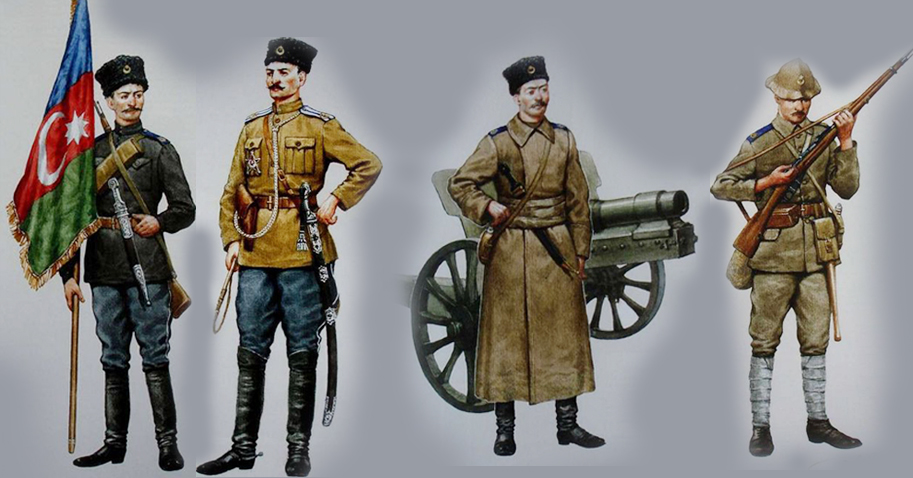Army
The formation of the armed forces of Azerbaijan Democratic Republic had been started from the day of declaration of the Republic. The Muslim army corps formed the basis of the newly established
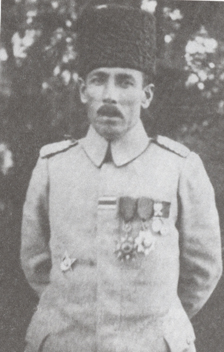
Caucasian Army of Islam
army. In order to provide the guidance for establishment of the army the Ministry of Defence was formed and Khosrov Pasha bey Sultanov was appointed a Minister of Defence of the first cabinet. But with the dissolution of the first cabinet the position of defence minister was also cancelled and by decision of the government the military build-up of Azerbaijan was assigned to Nuru Pasha, the commander of Caucasian Islamic Army. The position of commissioner on military affairs which would be charged with the duty of regulating the connections with the command of Caucasian Islamic Army was founded in the structure of the government and Ismayil khan Ziyadkhanov was appointed to the position.
On June 26, 1918, by the decision of the government the Muslim corps was termed Detached Azerbaijani corps and partial changes were made in its list of staff. Lieutenant general Aliagha Shikhlinski continued as a corps commander.
In order to make a significant breakthrough in military formation the government has implemented a number of measures. In early June, Ganja military school began its activity. The age limit for recruits was lowered to 19 by the decision of the government.
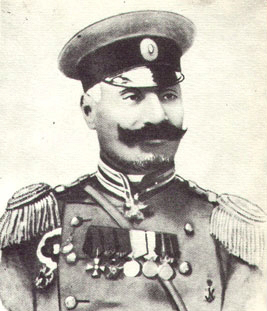
The initial phase of the army formation coincided with start of Baku Commissars Dashnak-Bolshevik military forces led by Stepan Shaumyan in active combat operations in Ganja direction.
On November 1, 1918, the Ministry of Defence was decided to be re-established in order to strengthen army formation. At first the chairman of the Council of Ministers Fatali Khan Khoyski assumed the leadership of the Ministry of Defence because of the great importance attached to this structure in performing the historical tasks of the government. General of the artillery Samed bey Mehmandarov was appointed a deputy minister and the formation of the ministry was assigned to him. Military command and control centres started to be built which were considered to provide the guidance for establishment of the army. Within a short time, the office of the Ministry of Defence was founded. On November 15, S. Mehmandarov signed the relevant decree on setting up of the General Headquarters of the army.
On November 22, 1918, the Ministry of Defence was moved to Ganja.
In late 1918 – early 1919, partial changes were made in the leadership and structure of the Ministry of Defence. According to the resolution of the
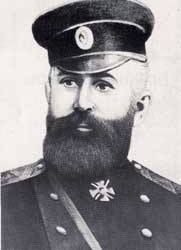
Council of Ministers dated December 25, 1918, general of the artillery Samed bey Mehmandarov was appointed a Minister of Defence and by the resolution dated December 29, 1918, lieutenant general Alagha Shikhlinski was appointed a deputy Minister of Defence.
The leadership of the Ministry paid great attention to regulation of the military service on a legal basis. By the decree signed by the Minister of Defence in early 1919, the military legislative acts adopted by the January 1, 1917 in Russian empire temporarily remained effective, as it was impossible to create the legislative framework for Azerbaijani army for a short time. This legislation included the training regulations, military manuals, the documents regulating all the aspects of military service, mobilization, instructions for carrying out the court martial etc. But some points of these legislative acts which were incompatible with independence of Azerbaijan, also with requirements of military service were abolished; those items were improved or replaced with new ones.
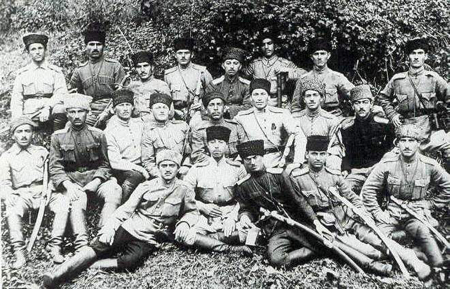
Azerbaijani language was adopted as the state language in army as well. Non-Azerbaijani officers were required to learn Azerbaijani equivalents of at least the command words within a month and to order the commands to the soldiers in Azerbaijani. The officers who could not fulfill that requirement were to be removed from the army immediately.
Measures were taken for preparation of national military personnel. The activity of the national military school in Ganja was reestablished and its status was raised to warrant officer school.
On January 10, 1919, interim council of war was established in the Ministry of Defence. The council was engaged in the discussion of important questions in the field of military legislation and military government and relevant decision making till its regulations and permanent composition were approved. Commanders of the infantry and cavalry divisions, the chief of the General Headquarters, also the chiefs of the artillery, field engineering and the newly established field equipment offices, quartermaster General, General on duty and task General were included in the interim council. In March, 1919, significant qualitative changes took place in the military authorities of Azerbaijani army. According to decree of the Minister of Defence, the general headquarters was established on March 26, and lieutenant-general Mammad bey Sulkevich was appointed a chief of the headquarters. After that, the formation of the army became more consistent.
In early April, 1919, Command of the British forces in Azerbaijan permitted a limited contingent of national army units to deploy in Baku as well. According to the decree of the Minister of Defence the units and division to be deployed in Baku were specified. Those forces were comprised of infantry battalion, 400 cavalry and an artillery battery. On April 5, the forces entered Baku and were deployed in Salyan barracks. Minister of Defence S. Mehmandarov came to Baku in connection with entrance of Azerbaijani troops to Baku. The city’s population met the Azerbaijani army troops with great enthusiasm and solemnity.
In summer and autumn of 1919, the formation of Azerbaijani army troops continued rapidly. In late June – early July 1919, the governing authorities of the Ministry of Defence were again moved to Baku
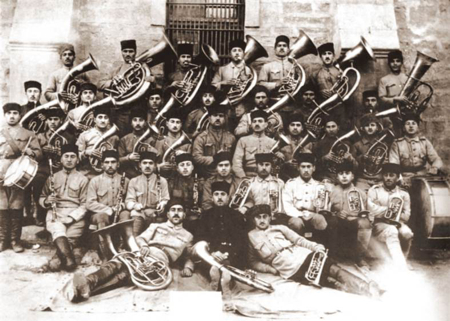
in connection with initial withdrawal of British troops from Azerbaijan.
From August 12 to September 3, 1919, the national army troops participating in Lankaran operation successfully fulfilled the combat mission ensuring the territorial integrity of the Republic.
One of the most important military structures established in the fall of 1919 was Baku combat engineering corps. Main purpose of formation of the corps was to prevent the threat of Denikin’s attack from the north, in particular from the sea, also to conduct a stubborn defence of Baku city in its entirety.
In September the staff vacancies of the military port of Baku, the group of airplanes, platoon of armoured cars started to fill up.
The National Army units included in Zangezur expedition fulfilled the combat mission against Armenians from November 3, 1919. The formation of special military units comprised of local residents in Zangezur was completed till the end of 1919.
Implementing all those organizational steps the Ministry of Defence intended to increase the number of Azerbaijani army staff to 20 thousand persons and the number of horse artillery to 5 thousand heads till the end of 1919, and in 1920, the number of Azerbaijani army staff to 40 thousand persons and the number of horse artillery to10 thousand heads.
Despite the deterioration of military situation at first in Karabakh, then in Lankaran and Zangezur in summer of 1919, the leadership of the Ministry of Defence was trying to keep the measured steps taken in army formation. As of the very first day of 1920, the 3rd armoured train was replenished. In the early 1920, the next mobilization campaign was launched and substantial structural changes were implemented in the supreme governing authorities of the army. In March of that year General Headquarters and General Staff united into General Headquarters of Azerbaijani Army. Central maintenance and provision authorities united into the procurement agency of Azerbaijani army.
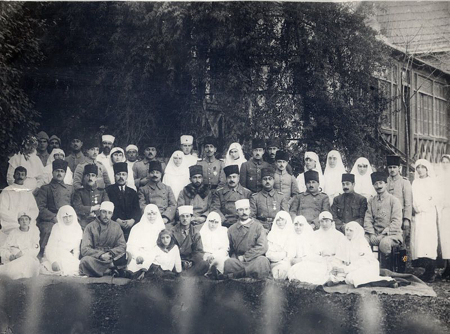
together with nurses. Ganja, 1918
On the eve of the Bolshevik invasion in 1920, the major combat units and formations of Azerbaijani army were the following: 2 infantry divisions consisting of 8 regiments, cavalry division consisting of 3 regiments and 2 artillery brigades. In addition to these, there were a number of auxiliary detachments, sections and enterprises in the army. Cavalry regiments consisted of three cavalry detachments, machine gun detachment, training and communication teams.
Artillery brigades consisted of two divisions. One of those divisions was light artillery division, while the other was a mountain artillery division.
In March, 1920, those forces were completely mobilized for Karabakh operation and the fight against the large-scale Armenian aggression in the border line with Armenia. As a result, the weakening of defence system of the northern border created more favourable condition for Bolshevik invasion. With the collapse of Azerbaijan Democratic Republic the army formation which served the country’s independence and national interests remained unfinished. Immediately after the April invasion in 1920, Republican army units were cancelled; material and technical basis created for the national army was plundered.
After the restoration of state independence of Azerbaijan on October 9, 1991, the Supreme Soviet of the Republic of Azerbaijan adopted a law on establishment of the army.
According to the Decree of the President of the Republic of Azerbaijan dated May 22, 1998, June 26 was declared the Day of the Armed Forces and is annually celebrated as a holiday.
